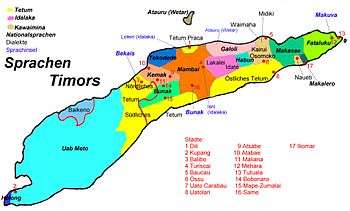Timoric languages
The Timoric, or sometimes Timor–Babar, languages are a group of fifty Austronesian languages (belonging to the Central–Eastern subgroup) spoken on the islands of Timor, neighboring Wetar, and (depending on the classification) the Babar Islands to the east.
| Timoric | |
|---|---|
| Timor–Babar | |
| Geographic distribution | Indonesia, East Timor |
| Linguistic classification | Austronesian |
| Subdivisions | (disputed) |
| Glottolog | None timo1260 (Ramelaic)[1] timo1259 (Fabronic/Extra-Ramelaic)[2] |
Within the group, the languages with the most speakers are Uab Meto of West Timor and Tetum of East Timor, each with about half a million speakers, though in addition Tetum is an official language and a lingua franca among non-Tetum East Timorese.
Languages
Unclassified Nauete is not close to other Timorese languages. Habu is structurally similar to Waima'a.
The Babar languages form their own group:
- Babar languages (see)
Hull (1998)
Geoffrey Hull (1998) proposes a Timoric group as follows:
- Ramelaic (near the Ramelau range)
- Extra-Ramelaic (Fabronic; whatever is not Ramelaic)
Van Engelenhoven
Van Engelenhoven sets up a South–East Timor branch including Tetun, Waimaha, and Luangic–Kisaric; the latter is as follows:[3]
Taber (1993)

Taber (1993:396) gives a Southwest Maluku and Babar group as follows, along with West Damar as an isolate.
- Southwest Maluku group
- Babar group
- North Babar subgroup
- South Babar subgroup
- Southwest Babar cluster
- Masela – Southeast Babar cluster
- Southeast Babar
- Serili
- East Masela
- Central Masela
- West Damar (isolate)
Edwards (2018)
Edwards (2018) proposes a Rote-Meto branch, with languages spoken on Rote Island and in West Timor.[4]
- Rote-Meto
- West Rote-Meto
- Dela, Oenale
- Dengka-Meto
- Dengka, Lelain
- Meto
- Nuclear Rote
Edwards (2019) also proposes a Central Timor branch that includes the recently documented language Welaun.[5]
- Central Timor
References
- Hammarström, Harald; Forkel, Robert; Haspelmath, Martin, eds. (2017). "Timoric B". Glottolog 3.0. Jena, Germany: Max Planck Institute for the Science of Human History.
- Hammarström, Harald; Forkel, Robert; Haspelmath, Martin, eds. (2017). "Timoric A". Glottolog 3.0. Jena, Germany: Max Planck Institute for the Science of Human History.
- Adelaar 2005:26
- Edwards, Owen (2018). Top-down Historical Phonology of Rote-Meto. JSEALS 11.1 (2018).
- Edwards, Owen (2018). Reintroducing Welaun. Oceanic Linguistics, Volume 58, Number 1, June 2019, pp. 31-58. https://doi.org/10.1353/ol.2019.0002
- Hull, Geoffrey. 1998. "The basic lexical affinities of Timor's Austronesian languages: a preliminary investigation." Studies in Languages and Cultures of East Timor 1:97–202.
- Taber, Mark (1993). "Toward a Better Understanding of the Indigenous Languages of Southwestern Maluku." Oceanic Linguistics, Vol. 32, No. 2 (Winter, 1993), pp. 389–441. University of Hawai'i.
External links
- LexiRumah (part of the Lesser Sunda linguistic databases)
- Reconstructing the past through languages of the present: the Lesser Sunda Islands
- The Languages of East Timor: Some Basic Facts (Revised 24.8.2004) Geoffrey Hull